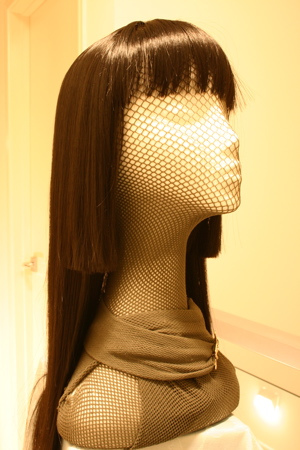Hime cut
Hime cut (姫カット, hime katto), also known as princess cut, is a distinctive style of haircut that originated in the Heian period of Japan. This hairstyle is characterized by straight, usually cheek-length sidelocks and a straight fringe. The rest of the hair can be left long or styled in various lengths. The hime cut has been a symbol of nobility and aristocracy, often associated with the image of a princess (hime) in traditional Japanese culture.
History
The hime cut has its origins in the Heian period (794–1185 CE), a time when Japanese court ladies wore their hair in a unique style that signified their status and beauty. During this era, women grew their hair as long as possible, and it was often considered a symbol of health and longevity. The hime cut, with its straight sidelocks and fringe, was a way to manage and style this long hair, making it a practical yet elegant solution for the noblewomen of the time.
Characteristics
The hallmark of the hime cut is its distinct layering and framing of the face. The sidelocks are cut cheek-length, framing the face, while the bangs are cut straight across the forehead. The rest of the hair remains long and straight, emphasizing the wearer's femininity and elegance. This hairstyle is versatile and can be adapted to various hair lengths and types, though it is traditionally worn with long, straight hair.
Cultural Significance
In Japanese culture, the hime cut is more than just a hairstyle; it is a symbol of purity, elegance, and nobility. It is often featured in manga and anime, worn by characters that are meant to embody these qualities. The hairstyle is also popular among J-pop idols and other celebrities, further cementing its status as a culturally significant and fashionable choice.
Modern Adaptations
Today, the hime cut remains popular in Japan and has gained international recognition thanks to the global spread of Japanese media. Modern adaptations have seen the hime cut styled with various hair colors, lengths, and textures, making it a versatile choice for many. Despite these variations, the core elements of the hime cut remain the same, preserving its historical and cultural significance.
In Popular Culture
The hime cut is a common sight in anime and manga, where it is often used to denote a character's traditional or noble background. Characters with a hime cut are typically portrayed as elegant, refined, or of high social standing. This hairstyle has become a visual shorthand for these traits, making it a popular choice for character designers.
See Also
Transform your life with W8MD's budget GLP-1 injections from $125.
W8MD offers a medical weight loss program to lose weight in Philadelphia. Our physician-supervised medical weight loss provides:
- Most insurances accepted or discounted self-pay rates. We will obtain insurance prior authorizations if needed.
- Generic GLP1 weight loss injections from $125 for the starting dose.
- Also offer prescription weight loss medications including Phentermine, Qsymia, Diethylpropion, Contrave etc.
NYC weight loss doctor appointments
Start your NYC weight loss journey today at our NYC medical weight loss and Philadelphia medical weight loss clinics.
- Call 718-946-5500 to lose weight in NYC or for medical weight loss in Philadelphia 215-676-2334.
- Tags:NYC medical weight loss, Philadelphia lose weight Zepbound NYC, Budget GLP1 weight loss injections, Wegovy Philadelphia, Wegovy NYC, Philadelphia medical weight loss, Brookly weight loss and Wegovy NYC
|
WikiMD's Wellness Encyclopedia |
| Let Food Be Thy Medicine Medicine Thy Food - Hippocrates |
Medical Disclaimer: WikiMD is not a substitute for professional medical advice. The information on WikiMD is provided as an information resource only, may be incorrect, outdated or misleading, and is not to be used or relied on for any diagnostic or treatment purposes. Please consult your health care provider before making any healthcare decisions or for guidance about a specific medical condition. WikiMD expressly disclaims responsibility, and shall have no liability, for any damages, loss, injury, or liability whatsoever suffered as a result of your reliance on the information contained in this site. By visiting this site you agree to the foregoing terms and conditions, which may from time to time be changed or supplemented by WikiMD. If you do not agree to the foregoing terms and conditions, you should not enter or use this site. See full disclaimer.
Credits:Most images are courtesy of Wikimedia commons, and templates, categories Wikipedia, licensed under CC BY SA or similar.
Contributors: Prab R. Tumpati, MD


